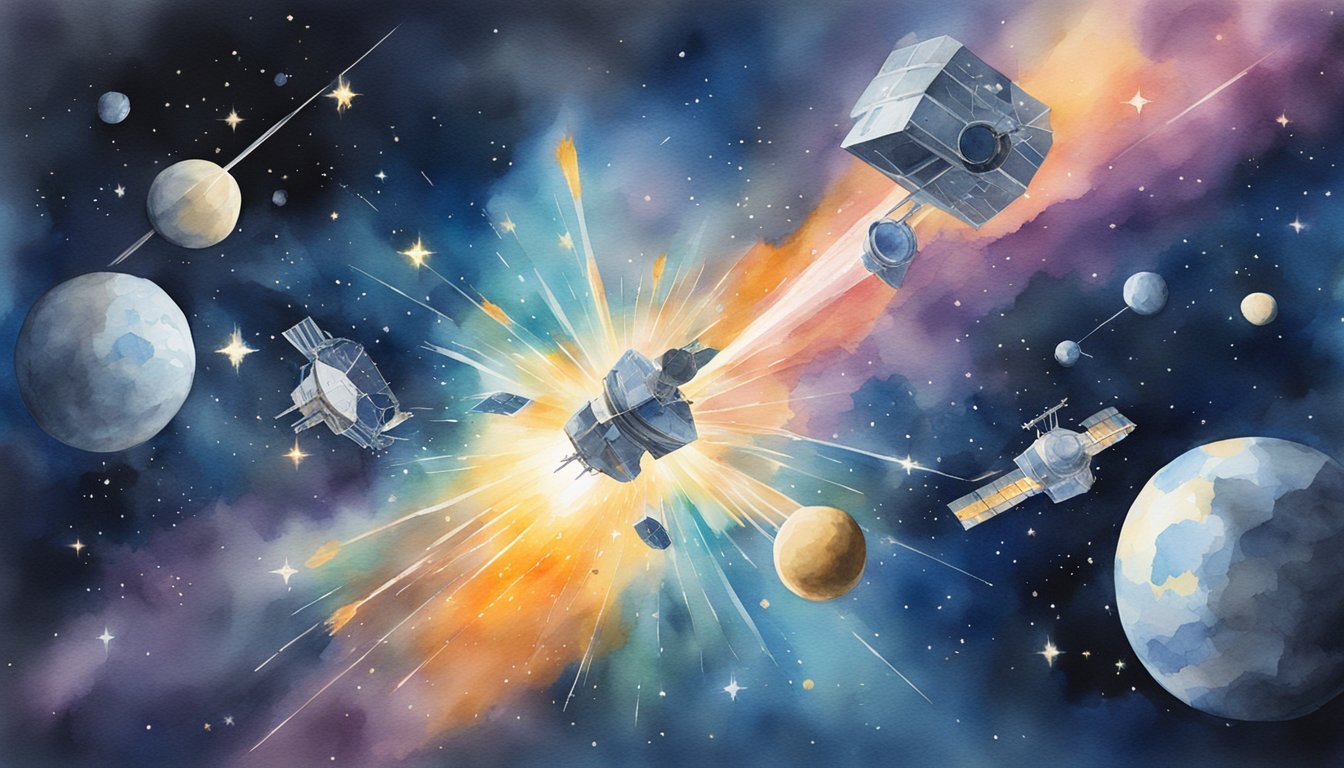Understanding Satellites
Satellites are a cornerstone in today’s global communication and scientific observation, serving a wide range of functions from detailed weather analysis to expansive geographical mapping. They have become integral tools for operational initiatives across various orbits.
Types and Functions
Types of Satellites:
- Communication Satellites: Enable global broadcasts, phone calls, and internet services.
- Weather Satellites: Crucial for meteorology, these satellites provide data for forecasting and climate study.
- Navigation Satellites: These spacecraft are behind GPS technology, offering precise positioning and timing.
- Earth Observation Satellites: They monitor environmental changes, resource management, and urban planning.
- Astronomical Satellites: Venture beyond Earth’s atmosphere to observe space phenomena.
Functions:
- Science and Research: Investigating Earth’s atmosphere, oceans, and land.
- Military and Security: Monitoring and data gathering for national security.
- Communication: Providing global coverage for various forms of media.
Orbital Mechanics
Low-Earth Orbit (LEO):
- Altitude: Approximately 160 to 2,000 kilometers (99 to 1,242 miles) above Earth.
- Characteristics: These spacecraft have shorter orbital periods, making them ideal for imaging and communication.
Geostationary Orbit (GEO):
- Altitude: Roughly 35,786 kilometers (22,236 miles) above the equator.
- Characteristics: Satellites here match Earth’s rotation, providing a fixed position in the sky – beneficial for continuous coverage over a specific area.
Orbital Patterns:
- Satellites travel in paths which are engineered to accommodate their operational needs, subject to the laws of physics driven by gravity and their velocity.
Satellites, though out of sight, weave an intricate dance high above Earth, fostering a connected and informed world. Whether observing weather patterns or linking phone calls across oceans, their silent orbit is a testament to human ingenuity in the pursuit of science and connectivity.
Satellite Constellations

In recent years, the night sky has begun to crowd with a new kind of star—a plethora of satellite constellations. These networks of artificial satellites work in concert to provide global services, such as high-speed internet.
Starlink and OneWeb
Starlink, forged from the vision of Elon Musk’s SpaceX, is rapidly unfurling its constellation of thousands of satellites in low Earth orbit (LEO). Aimed at delivering high-speed internet across the globe, these satellites have already made their mark as the pearly trails often seen streaking across the night sky.
Similarly, OneWeb is another significant player in the burgeoning megaconstellation arena. Despite encountering financial challenges, OneWeb has maintained its course and continues deploying satellites, intent on bridging the digital divide with broadband services.
Project Kuiper and Others
Amazon, not to be outdone, has unveiled its ambitious Project Kuiper. This initiative is poised to launch over 3,000 satellites into LEO, adding to the celestial internet infrastructure with the intention of providing low-latency, broadband services.
Beyond these giants are other competitors and start-ups, each eager to stake their claim in the high-flying real estate above. As the satellite megaconstellations expand, their collective presence promises to reshape not only how the world connects but also how it gazes upward at the heavens.
Impact on Astronomy

The increasing number of satellites streaking across the night sky presents significant challenges for astronomers conducting ground-based observations and raises concerns regarding space debris.
Challenges for Ground-Based Observations
Satellites contribute to light pollution, which interferes with the visibility of celestial objects. When a satellite crosses the field of view of a telescope, it can leave bright trails in the captured images. This issue affects not only professional astronomers but also amateur skywatchers. The result is a polluted sky that compromises data quality, making it difficult for astrophysicists to conduct precise astronomical observations. Research indicates that the fraction of the sky contaminated by satellite trails during twilight could increase with the rise of satellite constellations.
Space Debris Issues
Space debris poses a real threat to astronomy. Ground-based telescopes, while powerful, are not immune to the risks posed by thousands of satellites and debris orbiting Earth. Collisions between satellites might create more debris, leading to a potential cascade effect known as the Kessler Syndrome. This growing cloud of space debris around Earth makes certain areas of space traffic-heavy and risky for both satellites and astronomical research. The mitigation of such impacts is under discussion within the international astronomical community.
How Do Satellites Help Us Monitor Asteroids and Protect Against Potential Hits to Earth?
Satellites play a crucial role in monitoring asteroids, providing real-time data and tracking their trajectories. This technology debunks the “asteroid impact myth versus reality,” showing that while some asteroids pose risks, many are harmless. Continued observation and study enhance our readiness and understanding of potential threats from space.
Observing the Night Sky

Gazing up at the night sky opens a window to the universe, from spotting the sparkling constellations to witnessing the planets in motion.
Identifying Objects
In the tapestry of the night sky, stars twinkle alongside grander structures like the Milky Way. Identifying celestial objects is both thrilling and educational. Novice stargazers can use various stargazing apps to pinpoint objects such as the Big Dipper or Jupiter. These apps not only provide real-time maps of the sky but can also highlight upcoming skywatching events.
- Constellations: Visible patterns like Ursa Major can guide viewers to other stars.
- Planets: Looking for steady lights, unlike the twinkling stars, can reveal planets.
-Bold Galaxies: On a clear night, and away from light pollution, some galaxies besides the Milky Way can be spotted with the naked eye or with binoculars.
Remember, the Northern Hemisphere affords a different view from the Southern, offering unique celestial sights such as the Northern Lights.
Best Practices for Skywatching
Skywatching can be an impromptu event or a planned excursion. Here are some best practices to enhance the experience:
- Avoid Light Pollution: Seek out dark sky areas for the clearest view.
- Use the Right Equipment: A good telescope can bring distant planets and galaxies into focus, while a simple pair of binoculars can also enrich the experience.
- Consult Sky Charts: Paper charts or apps can help identify what you’ll see on any given night.
- Check the Weather: Cloud-free skies are a must for unobstructed views.
- Attend Local Events: Many communities and astronomy clubs host star parties and other gatherings for collective observation.
Italic Whether they are chasing the chance to see the faint glow of a distant galaxy or the bright bands of Jupiter, stargazers should embrace patience and curiosity on their celestial quests.

